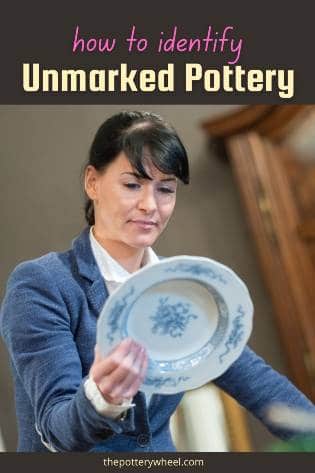In theory, it is possible to identify pottery with no markings just by looking at it. But in reality, this is an almost impossible task. Pottery was often handmade, and every country and even region had its own distinctive style. Well-known artists like Picasso, and less well-known ones like Grueby, made their careers out of experimenting with ceramics and glazes.
The easiest way to identify pottery with no markings is through its physical attributes, such as its color, texture, hardness, weight, and design. If you are not experienced enough to correctly examine pottery without markings, it is advisable to consult an expert to help identify the piece.
In general, identifying pottery when there are no markings is as much a matter of establishing the period (sometimes called a “horizon”) as it is of establishing a specific maker or school of makers.

Identifying Unmarked Pottery
Unmarked pottery can be hard to place as it lacks identification marks such as dates, numbers, logos, or stamps. A keen and experienced eye is required to accurately identify unmarked pottery based on physical attributes.
As aforementioned in the intro above, these parameters include color, size, type of glazing, and the flowers and patterns used to decorate the pieces. They are discussed in more detail below:
Use of Size
Some pieces of pottery can be correctly identified through their size. This is because some sizes are associated with a certain location and a period of time. For example, American pottery is generally thick and heavy compared to pottery from other countries. It is also known to have a heavy bottom.
Use of Color
The color of the pottery is determined by the color of the clay used to create it. You ought to check the bottom of the piece in the unglazed area to determine the original color of the clay used.
Different colors of clay were used at varying times, and others are synonymous with particular regions. For instance, red clay is heavily associated with Oklahoma and beige clay with Kansas in America. The discoloration of clay can also be heavily indicative of its origin.
Type of Glaze
The type of glaze used can be used to indicate the approximate age of a piece of pottery. Also, it can be used to determine whether ceramic is antique or faux. For this, check the unglazed places of pottery, such as the bottom of the piece.
Use of Decoration
Look at the designs and patterns painted on the piece as they hint at the piece’s origin. For example, moriage china pottery can be identified by pastel colors and intricate floral designs that are laid in small ribbons of clay.
Willow pieces can be identified by their distinct patterns that involve blue and white willow, orange and apple trees, birds, boats, and people on a bridge.
Additionally, check for designs and indentations found at the bottom of the piece. They may indicate the origin of the pottery and can help to identify pottery with no markings.
Identifying China Pottery with No Markings
Old china pottery is among the most valuable artifacts around. Usually, china pottery has marks to identify it and set it apart.
Other times, though, it comes unmarked. In this case, old china pottery can be identified using several parameters, more so their shape and decorations. The patterns on china pottery are based on the period of production.
Essentially, there are three types of china pottery: bone china, hard-paste porcelain, and soft-paste porcelain. While each of these types has unique characteristics that distinguish them, they all have similar primary features.
One way of identifying unmarked china is through their patterns. Most china potteries have unique designs that make them stand out. The common patterns are bright and glide in gold. Pieces with flowers, willows, and rivers are normally associated with this pottery.
While some types of china pottery may have similar designs, they can be differentiated using the glaze. The glaze of china pottery is smooth, with hardly any breaks or cracks. Also, it is leveled perfectly such that it is perfectly balanced when placed on a flat surface.
If you’d like to know more about how to identify bone china with no markings, you can check out an article I wrote on exactly that subject here. This will give you a comprehensive idea of what to look for when identifying bone china with no markings.

Identifying American Pottery with No Markings
The best way to determine whether a piece of pottery is American is to look at the bottom of the piece. For American pottery, the bottom tells more than just the glaze type used on the piece. It also tells the color of the clay and how it was fired.
Weight
One way of identifying American pottery is its weight. Comparatively speaking, American pottery is heftier than pieces from Europe and Asia. Also, the relationship between weight and size for American pottery is such that these pieces tend to be too heavy for their size.
Essentially, American pieces tend to have “heavy bottoms .”Still, being able to identify these pieces by their weight is a skill that is developed over time. Moreover, it is important to note that the walls of American pottery pieces are thicker than foreign potteries.
Color
Another way to identify unmarked American pottery is through color. For this, you ought to check the unglazed area of the piece to catch the original color of the clay used, which is the bottom of the piece. Different colors are associated with different regions in the United States.
For instance, red clay is linked to Oklahoma, just as beige clay is associated with Kansas. Similarly, yellow and pink clay shows that the piece could be from Hull or Shawnee- two major pottery production companies of the 20th century.
In American pottery, the glaze would go with the fashion of the time. Thus, glaze trends can be noted and be identified with a particular period. Standard glaze, which is made up of a shiny brown finish, was popular at the turn of the 20th century.
The matte finish was the trend some time in the 1915s to 1930s. During the late 30s and 50s, some companies adopted a shiny glaze for their pieces. Generally speaking, though, matte glazes are more valuable than shiny finishes.
Identifying Unmarked Porcelain
Porcelain is a type of chinaware that is stronger and has better durability than normal china pottery. One reason for this is that during production, porcelain is subjected to high temperatures. It is also made with a special type of clay called kaolin.
Essentially, porcelain is translucent and relatively lightweight. One can identify it by tapping the piece lightly. Porcelain produces a comparatively louder sound than other types of chinaware.
Also, it has a unique shape that was not common at the time of its production – most porcelain pieces are cylindrical or, at the very least, pear-shaped.
Another way of identifying unmarked porcelain pottery is through the color test. At the time porcelain was being produced, potters would use colors that were not very common.
So, a piece that had an unknown/distinct color would immediately be identified as porcelain. Even so, most potters would use blue dye on the pottery.
You can also identify porcelain by examining the type of glazing used on it. For this, you may have to turn the piece and check the unglazed area at the bottom.
Porcelain’s glazing technique is highly refined- so smooth and articulate. If, at this point, you still can’t confidently conclude that the piece of pottery is porcelain, then consult an expert.
How To Tell If Unmarked Pottery in Antique or Faux
Since antiques are valuable, many faux potteries are disguised to look like antiques. In many instances, an inexperienced eye would have a hard time distinguishing between faux and antique pieces, especially when they are unmarked.
One way to check if unmarked pottery is antique or faux is by checking the bottom of the piece. The bottom has an unglazed area, revealing the type of clay used on the piece.
Clay used to make antique pieces is old and dusty compared to the one used on faux pieces. At times, faux pieces are made to look older than they actually are by being painted brown.
Therefore, it is advised that you use a clean towel to wipe the bottom of the piece thoroughly. If it is dusty and dirty, then the piece is an antique. However, if the bottom is clean, it most probably is a disguised faux.
Antique pottery comes in three main forms – stoneware, porcelain, and earthenware – each with its own characteristics. Some antiques are extremely valuable, especially if they are no longer in production. If, after checking, you are still not sure whether a piece is antique or faux, consult an expert.
Final Thoughts
There is a common misunderstanding that pottery with no markings is not valuable. Many people expect sellers to sell unmarked ceramics at a low price. An unmarked piece of pottery is one that has no logo, stamp, date, or number.
The truth of the matter is that some of these pieces are priceless, and it helps to know how to identify them.
As established in this article, there are several ways to identify pottery with no markings. They involve examining the physical attributes of the artifact, such as the weight, color, glazing type, and design. There is also the option of consulting an expert for surety. In any case, examining unmarked pottery consistently for several years will make you an expert yourself.




